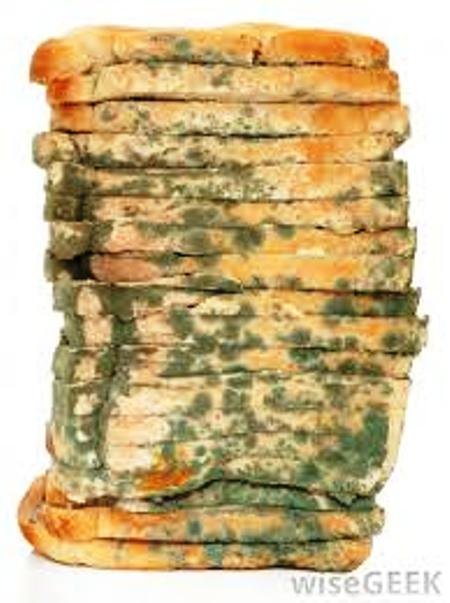
photo credit: Wisegeek.com
Ever wonder what Mycotoxins or moulds are and what they do?
WHAT ARE MYCOTOXINS?
Mycotoxins are secondary metabolites produced by moulds which contaminate foods and have toxic effects on the health of humans and animals.
Fungi are ubiquitous plant pathogens that are major spoilage agents of foods and feedstuffs.
The infection of plants by various fungi not only results in reduction in crop yield and quality with significant economic losses but also contamination of grains with poisonous fungal secondary metabolites called mycotoxins. (Olusegun et al, 2013).
According to the food act of provisional translation by ministry of European integrations, food shall mean any substance or product, processed, partially processed or unprocessed, intended for human consumption or which can be expected to be consumed by humans.
Contamination refers to the non-intended or accidental introduction of infectious materials like bacteria, yeast, mould, fungi, virus, prions, protozoa or their toxins and by-products. (Braun, 2015).
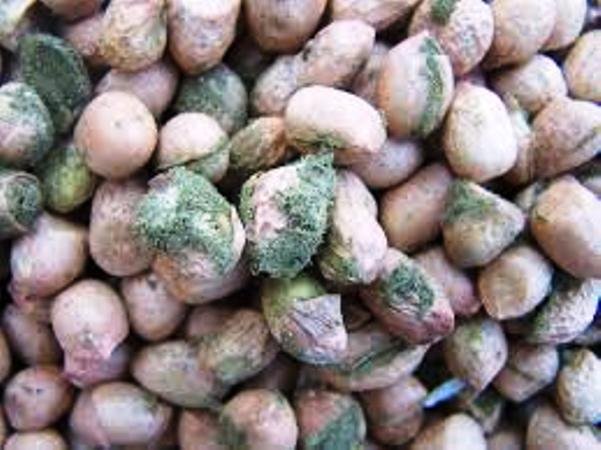
photo credit: www.fafdl.org
HOW FUNGI PRODUCE MYCOTOXINS
Fungi proliferate to produce secondary metabolites under favourable environmental conditions, when temperature and moisture are suitable. Fungi are a normal part of the micro flora of standing crops and stored feeds, but the production of Mycotoxin depends upon the fungi present, agronomic practices, the composition of the commodity and the conditions of harvesting, handling and storage Fungi proliferate to produce secondary metabolites under favourable environmental conditions, when temperature and moisture are suitable. Fungi are a normal part of the micro flora of standing crops and stored feeds, but the production of mycotoxin depends upon the fungi present, agronomic practices, the composition of the commodity and the conditions of harvesting, handling and storage mycotoxins are secondary fungal metabolites mainly produced by species from the Aspergillus, Penicillium, and Fusarium genera which contaminate foods and have toxic effects on the health of humans and animals.
Several fungal metabolites which are toxic in experimental systems abound, however, there are only five that are of major agricultural importance: aflatoxin, produced by Aspergillus flavus and A. parasiticus; deoxynivalenol, produced by Fusarium graminearum and F. culmorum; fumonisin; produced by Fusarium verticillioides (exmoniliforme); ochratoxin, produced by Aspergillus ochraceus and Penicillium verrucosum; and zearalenone, produced by various Fusarium species. These toxins produced by fungal species remain stable throughout the processing periods and cooking of feeds and foods (aflatoxin, ochratoxin, fumonisin, deoxynivalenol.
Fungal infection and subsequent production of Mycotoxin can occur at the field during crop growth or harvesting, and may continue during storage. (Ukwuru et al, 2017). Below is a photo of a corn cob infected by moulds due to poor storage.
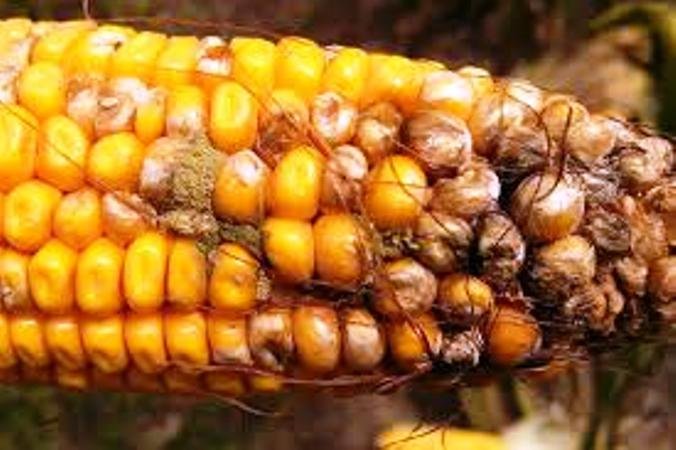
photo credit: www.zootechnicainternational.com
FACTORS THAT FAVOURS THE PRODUCTION OF MYCOTOXINS
Mycotoxin production, especially on grains, is highly dependent on pre and/or postharvest environmental factors (e.g., temperature and moisture content). Climate represents the key factor in mycotoxin and fungal occurrence. Mycotoxins are climate-dependent compounds but several factors can affect their presence, such as bioavailability of micronutrients, insect damage making it a complex and multifactor phenomenon. These metabolites are usually subdivided into field mycotoxins, produced on cereal crops before or immediately after harvest mainly by Fusarium spp., and storage mycotoxins, primarily secreted by Aspergillus and Penicillium spp. during commodity drying and storage. (Marie-Caroline et al, 2016).
EFFECTS OF MYCOTOXIN INGESTION
Mycotoxin ingestion may induce various chronic and acute effects on humans and animals, such as hepatotoxic, genotoxic, immunosuppressive, estrogenic, nephrotoxic, teratogenic, and/or carcinogenic effects. (Marie-Caroline et al, 2016). They are also capable of causing acute and chronic effects in man and animals ranging from death to disorder of central nervous, cardiovascular, pulmonary systems and intestinal tract. Moreover, mycotoxins are not completely eliminated during food processing operations and can contaminate finished processed food products. (Marie-Caroline et al, 2016).
Afsah-Hejri et al (2013) stated that mycotoxins may be inhaled, ingested, or absorbed through the skin. No matter how mycotoxins are entered, they can cause sickness, lower performance, or death in both animals and humans and that mycotoxicosis is the consequence of ingesting mycotoxin-contaminated food or feed by higher animals. Sometimes, mycotoxicosis is caused through indirect ways such as consumption of products from animals (milk or meat) exposed to contaminated feed.
Noteworthy, mycotoxins may occur in modified forms from their parent compounds, due mainly to plant detoxification systems. Indeed, as part of their defence against xenobiotics, plants can alter the chemical structure of mycotoxins by modifications generated by enzymes involved in detoxification processes. Because these modifications lead to modified chromatographic profiles, epitope conformation or polarity, these mycotoxin derivatives usually escape conventional analytical methods and are not regulated by legislation and thus are called “masked” mycotoxins. Even if in the case of several studied conjugated mycotoxins, a lower toxicity was observed compared to the parent compounds, a potential increased bioavailability during digestion of masked mycotoxins still represent a health threat. As masked mycotoxins are an emerging issue and insufficient toxicological and quantification data are available. (Marie-Caroline et al, 2016).
Afsah-Hejri et al (2013), in their review on mycotoxins in foods and feeds stated that mycotoxin contamination of agricultural crops may occur in 2 ways; the first is when fungi grow as pathogen on a plant and the second one is when fungi grow saprophytically on stored crops. Cereals (wheat, rice, maize, and sorghum), oilseeds (sunflower, peanut, cottonseed, and soybean), spices (black pepper, chillies, turmeric, coriander, and ginger), tree nuts (pistachio, almond, coconut, and walnut) are the most important agricultural commodities that can be contaminated with mycotoxins. Milk (animal and human), cheese, and butter can be a source of mycotoxin contamination if mycotoxin contaminated food or feed is consumed. (Afsah-Hejri et al, 2013)
It should be mentioned that observation of fungi does not necessarily mean presence of mycotoxins, and not all fungal growth results in mycotoxin production. Fungal growth and toxin production depends on environmental factors (such as warm temperatures and high humidity). Therefore, agricultural products in subtropical and tropical regions are more susceptible to fungal infestation, and consequently, mycotoxin contamination. If subtropical and tropical countries have poorly developed infrastructures (such as processing facilities, transportation, storage, and skilled human resources), more mycotoxin contamination may be observed. Based on the moisture requirements, mycotoxin producers can be divided into 3 groups: field fungi, storage fungi, and advanced decay fungi. The field fungi mycotoxin producers require a grain moisture content of 22% to 25%, while storage mycotoxin producers usually grow in grain with a moisture content of 13% to 18% (equal to 70% to 90% relative humidity), and advanced decay fungi require over 18% moisture. (Afsah-Hejri et al, 2013).
Mycoses and mycotoxicoses are the major ways in which human and animal health is affected due to infection with fungi and contamination with Mycotoxins. When this happens the implications are wide and span from health to economics. Mycosis means fungal infection of man or animals and range in its simplest form from growth that merely annoys the victim to a more complex form of life threatening invasion. Mycotoxicosis on the other hand could be defined as a disease outbreak that is commonly associated with the ingestion of mycotoxins or inhalation of spores produced by fungi. The appearance of mycotoxicoses symptoms depend on the level of contamination, length of exposure, type of mycotoxins, degree of combination with several other mycotoxins, individual differences, species-specific resistance, sex, pre-existing pathological and physiological status of the victim. Therefore, it is possible that vitamin deficiency, caloric deprivation, alcohol abuse and infectious disease status can all have compounded effects with mycotoxins. Mycotoxins have the potential for both acute and chronic health effects through ingestion, skin contact and inhalation. These toxins can enter the blood stream and lymphatic system and inhibit protein synthesis, damage macrophage systems, particle clearance of the lung and increase sensitivity to opportunistic infections. If symptoms appear within a short period of less than 7 days of contamination, it is termed “acute mycotoxicoses” but if the interval between contamination and appearance of the symptoms persist longer, it is termed “chronic mycotoxicoses”. In acute cases, victim may die if adequate treatment measures are not taken whereas in chronic cases, the victim may live longer though with protracted illnesses. (Olusegun et al, 2013)
SOLUTIONS AND CONTROL
Many control strategies for mycotoxins contamination of foods have been proposed and implemented with varying degrees of successes. Suggested strategies include good agricultural practices (GAP), good manufacturing practices (GMP), biological control and transgenic approaches. These approaches are designed for mycotoxins control programs that will have economic impact as well as health improvement in the region. Many developing countries are gradually getting to know that reducing mycotoxin levels in foods will improve international trade advantages with a concomitant long-term health benefit to the local population. In most countries of the world, there is lack of understanding about mycotoxins contamination of foods. The focus on mycotoxin research should be centred on toxicity, exposure, mitigation impact and analytical aspects. A public private partnership to achieve this focus has been advocated. Under this arrangement, there should be a science driven body with volunteering scientists and public interest that will have a scientific discussion on the way forward for the control of mycotoxins in food and feeds.
This is based on the fact that improvement of scientific knowledge in mycotoxins exposure and mitigation of contaminants in foods will ensure safer food products. Public health must be maintained through adversary on the scientific knowledge of mycotoxins and the extent of the impact of their potential risk to health. This scientific framework when developed should not be localized but exchanged and reviewed as frequently as possible to handle issues of analytical methods and emerging mycotoxins. Advocating good manufacturing practices is quit broad and it involves the physical food processing methods which are believed to reduce mycotoxins to a reasonable extent. Such methods include sorting, dehulling, milling, dewatering, enzymatic and microbial activities like malting processes in the brewery operations, fermentation etc. These are areas that require further investigations on how they reduce the risk of mycotoxins contamination. Natural products have also been proposed to reduce mycotoxins. Eugenol has been found to inhibit aflatoxin production but does not affect fungal growth. It acts at the transcriptomic level, thereby blocking the biosynthetic pathway which occurs at the early stage. Many more natural products of plant or animal origin may be evaluated in this same direction. Biotransformation can be used to mitigate mycotoxins by identifying the metabolites formed during biotransformation and verify that that the metabolites are non-toxic.
Education and extension services where regular programs on radio and televisions on mycotoxin hazards and discussion on the issue should feature regularly on daily newspapers and magazines has been proposed. There are diverse opinions on the use of chemicals to control mycotoxins. Some researchers said seed fumigation with ethylene oxide and methyl formate was found to significantly reduce the incidence of fungi including toxigenic species on stored groundnuts and melon seeds. It was reported that sodium chloride (2.5, 5.0 and 10.0%), propionic acid (1.0, 2.5 and 5.0%), acetic acid (1.0, 2.5 and 5.0%) inhibited aflatoxin B1 production in A. flavus inoculated groundnuts and maize kept in gunny bags. FUMs contamination could be reduced by application of fungicides that have been used in control of Fusarium head blight, such as prochloraz, propiconazole, epoxyconazole, tebuconazole cyproconazole and azoxystrobin. On the other hand, application of fungicides has been shown to effectively control the AF producing Aspergillus species. Chemical reduction of FUM toxicity can be achieved through the use of allyl, benzyl and phenyl isothiocyanate in model solution and in food products. The BEA reduction varied from 10% to 65% in wheat flour and was dose-dependent with allyl isothiocyanate. A contrary opinion to all these indicate that chemical detoxification lead to potential toxic metabolites, reduction in nutritional value and changes to food products. Biological control programs using microorganisms to detoxify mycotoxins are other measures that are widely used. The International Institute for Agricultural Research (IITA) has pioneered this technique in Nigeria, by the development of its product called Aflasafe. Aflasafe has proven successful and is being tried on a number of crops. Other reports of biological control are the introduction of a toxigenic strains of A. flavus and A. parasiticus to soil of developing crop resulting in 74.3 to 99.9% reduction in aflatoxin contamination of peanuts in the US and 68-87% reduction in aflatoxin contamination in cotton seed. Saccharomyces cerevisiae reduced the AFB1 concentration in peanuts by 74.4%. Control of FUM-producing fungi by endophytic bacteria has also been reported. Trichosporon mycotoxinivorans used as an OTA deactivator in broiler feeds has been recently reported. Lactic acid bacteria, such as Bifidobacterium bifidum and Lactobacillus rhamnosus, are suggested to be a promising biological control strategy for PAT in aqueous solutions. Fungal strains of Trichoderma have also been shown to control pathogenic fungi through mechanisms, such as competition for nutrients and space, fungistasis, antibiosis, rhizosphere modification, mycoparasitism, bio fertilization and the stimulation of plant-defence mechanisms.
Generally, mycotoxin contamination of agricultural products can be prevented using the following methods:
- Pre-harvest methods:
a. using resistant varieties
b. field management
c. use of biological and chemical agents
d. harvest management - Post-harvest methods:
a. improved drying methods
b. good storage conditions
c. use of natural and chemical agents
d. irradiation.
Other methods include
• Collection of a database of predominant fungi and mycotoxins in Nigeria.
• Construction of a Mycotoxin Occurrence Map to know the areas prone to Mycotoxin contamination.
• Establishment of a permanent culture collection centre. (Ukwuru et al, 2017).
Good agricultural Practices
Good Agricultural Practices is a collection of principles to apply for on-farm production and post-production processes that will result in safe and healthy food and non-food agricultural products. Activities to ensure good agricultural practices must be given a holistic approach to tackle the menace of mycotoxins. Efforts to mitigate mycotoxins contamination will be successful if all good agricultural principles are put in place by farmers in Nigeria and the world.
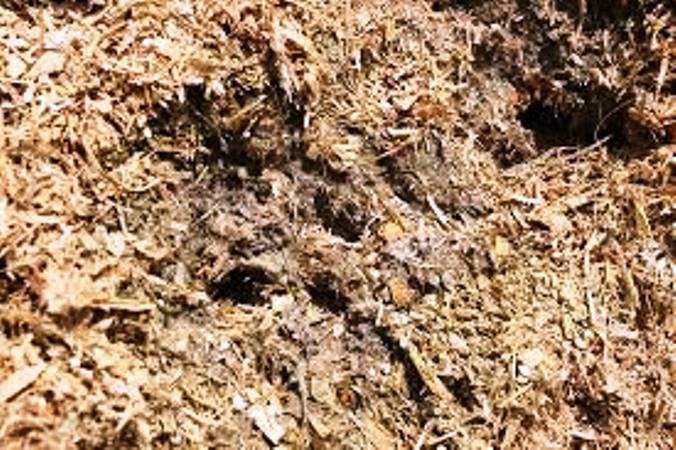
photo credit: www.biomin.net
Soil
Under good agricultural principles the type of land, soil conditions, soil management must not have any negative effect on the biodiversity. GAP also lead to soil productivity, availability, uptake of water and nutrients through enhanced soil biological activity. The soil organic matter replenished, losses of soil moisture, nutrients, and agrochemicals through erosion is reduced, and runoff and leaching into surrounding environment, sediments, nutrients movement, and mobility of livestock and associated species including predators, pests and biocontrol agents are brought under control.
Pre-harvest interventions
Crop management at the pre harvest stage is critical to mycotoxin reduction. Planting, pre
harvest and postharvest strategies for a particular crop depends on the climatic conditions
of that particular year, taking into account the local crops, and traditional production conditions for that particular country or region. Wet weather either during flowering or at harvest is also a major risk factor. In general, pre harvest management must ensure that insect damage and fungal infection in the vicinity of the crop must be minimized by proper use of registered insecticides, fungicides, herbicides and making sure that mechanical injury to plants during cultivation is minimized. Seed varieties that are resistant to insect pest and diseases should be procured. Irrigation is a valuable method of reducing plant stress that is sometimes responsible for mycotoxin development crops in some growing situations. Crop rotation should be developed and maintained but crops identified to be susceptible to toxigenic moulds should not be used in rotation with each other. Grains should be harvested at full maturity, cleaned and infected seeds removed using procedures such as gravity table. They should be promptly dried to low moisture levels (13%) before storage where applicable. Moisture levels of the crop should be determined at several spots during harvest, immediately after harvest, before and during storage in barns or silos. Sampling for such test should be as representative of the lot as possible.
Storage

photo credit: www.fera.co.uk
Storage is a critical stage where infection and mycotoxin accumulation occur. Care must be
taken to store grains that are wholesome and apparently healthy. Prestorage treatment or handling should take care of certain basic issues. Winnowing grains at harvest or later should be done to remove shrivelled small grains which may contain more zearalenone than healthy normal grains. Harvesting and storage conditions should be documented with daily temperature and humidity checks. Wet grains provide suitable environment for mould growth and should not be piled up for a long time to reduce the risk of fugal growth. Bagged commodities should be stored on pallets. Storage facilities meant to exclude mould growth should include dry and well-ventilated structures, provide protection from rain, drainage of ground water; prevent entry of rodents and birds, and minimum temperature fluctuations.
Biological control measures
The potential for using microorganisms to detoxify mycotoxins has been reported to be promising. One of the management strategies that had been developed is biological control using the competitive exclusion mechanism, which has been successfully implemented in the US, biological control has been used to reduce aflatoxin contamination in various crops such as cotton, maize and groundnut.
Physical methods of mycotoxin removal
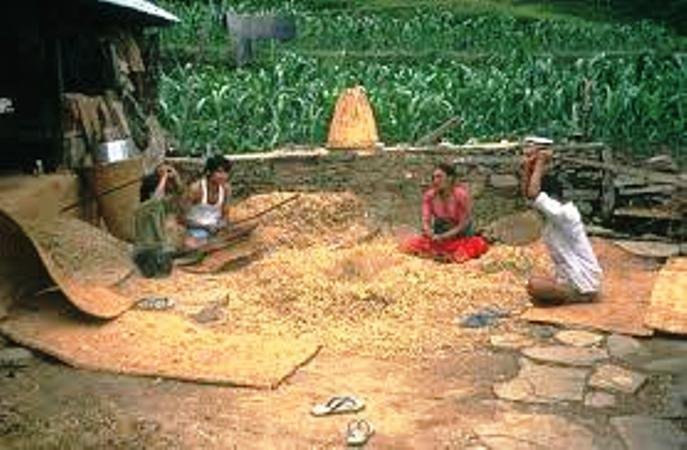
photo credit: www.apsnet.org
Once a contaminated product has reached a processing facility, clean-up and segregation are the first control options. In some cases, these are the best methods of reducing mycotoxin presence in final products. For example, when peanuts are processed, a significant amount of aflatoxins can be removed by electronic sorting and hand-picking; separation of mould-damaged maize and/or screening can significantly reduce fumonisin and aflatoxin concentrations. In addition, the removal of rot from apples significantly reduces the patulin content in the final product. Although some contamination may persist, physical removal represents a good alternative for industry. It is however important for grain handlers to use masks to avoid inhalation and ingestion of spores (as mould spores and mycotoxins are often concentrated in the fines and dust of grains). In general, good agricultural practice entails a holistic approach and involves risk assessments throughout the process. These risk assessments can be performed at three points during the season: at the start of the season to assess the agronomic risk, at ear emergence to assess the need for spraying with insecticide and at harvest to assess the overall risk.
INTERNATIONAL AND NATIONAL REGULATIONS FOR MYCOTOXIN
To date, 100 countries have established regulations to protect consumers from the harmful effects of mycotoxins. Depending on the country, human foods are allowed a total of 4 to 30 ng/g of AFs. The maximum total AF residue limit in human food in the U.S.A. is 20 ng/g, and 4 ng/g is the maximum amount of AFs allowed in food in the EU, which has the strictest standards worldwide. According to the European Committee Regulations, the AF maximum permitted level in peanuts, dried fruits, and cereals (for direct human consumption or as an ingredient in foods) is set as 5 ppb for AFB1 and 10 ppb for total AFs (Moss 2002). Due to the harmful effects of OTA and increasing knowledge of health hazards, many countries have established a limit for OTA in food and feed. At the 37th, 44th, and 56th meetings of the Joint FAO/WHO Expert Committee on Food Additives (JECFA), a provisional tolerable weekly intake (PTWI) of 100 ng/kg BW for OTA was established. In a recent proposal from the European Union (EU), which has been effective since October 1, 2006, the maximum tolerated limit for OTA was reduced to below 5 ng/kg BW/d. According to the European Commission (Regulation 1881/2006), the maximum contamination level of OTA in processed cereal-based foods and baby foods for infants and young children and dietary foods for special medical purposes intended specifically, for infants is 0.5 ng/g, while for unprocessed cereals and coffee, it is 5 ng/g. Based on the FAO’s worldwide regulations for mycotoxins in food/feedstuffs, several countries have set the maximum residual limit for ZEN in maize and cereal at less than 100 ng/g. According to the JECFA, the maximum tolerable daily intake for ZEN is 0.5 μg/kg BW, while tolerance levels ZEN in food in Europe are 60 to 200 ng/g (El-Nezami and others 2002). According to European Commission Regulation 2007, the maximum residue limit for ZEN in unprocessed cereals, unprocessed maize, cereal for direct consumption, maize for direct consumption, and processed maize/cereal-based foods is 100, 350, 75, 100, and 20 ng/g, respectively and the maximum level of ZEN in wheat bran (used as ingredient in high fibre breakfast cereals) should not exceed 125 μg/kg. According to the Joint FAO/WHO Expert Committee on Food and Additives, the permitted level of T-2 toxin is 1 μg/kg BW. In most food products, the maximum tolerated level for DON is in the range of 500 to 1000 μg/kg but the European Commission Regulation of 2007 has set the maximum permitted level for DON in cereal-based foods for infants and children, as well as cereals intended for direct human use and finished wheat products for human consumption at 200, 750, and 1000 ng/g, respectively. Some countries (Russia and France) have set a maximum permitted level for T-2 toxin in malt and unprocessed cereals at 100 ng/g. In Slovakia, the maximum permitted level for T-2 toxin in cereal-based foods for children is set at 0.5 ng/g (FAO 2004). In other European countries, the maximum permitted level for DON in feed is 400 to 5000 ng/g. According to the European Commission regulation, maximum residual limits of FB1and FB2 in cereals, maize for direct consumption, maize-based breakfast cereals, and maize-based foods/baby foods are 4000, 1000, 800, and 200 ng/g, respectively. To avoid apoptosis and sphingolipid metabolism disruption related to the potential carcinogenicity of FMN, daily intake of <1 μg/kg BW/d has been suggested. The recommended level of FMN in animal feed (for cattle and poultry) is 50 μg/g. (Afsah-Hejri et al, 2013).
Conclusion
Mycotoxins contamination of food commodities remain a worldwide menace. Prevalence rate on foods and feeds differ from one region to another due to geographical factors that affect the growth of fungi and subsequent toxin production. Mycotoxins have occurred in many foods largely unknown to a number of consumers. Mycotoxins contamination of foods has adversely affected human health and international trade. The use of media to create the much needed awareness is a good strategy for control and reduction of mycotoxin contamination of foods and feeds. (Ukwuru et al, 2017)
Some of the suggested solutions to mycotoxin menace in Nigeria include:
- Collection of a database of predominant fungi and mycotoxins in Nigeria
- Construction of a Mycotoxin Occurrence Map to know the areas prone to Mycotoxin contamination
- Establishment of a permanent culture collection centre
- Good Agricultural practises (early planting and use of recommended crop production
practices, irrigation to reduce drought stress, early harvesting, prevention of kernel damage during harvesting), Storage (adequate drying and proper storage below 13 % moisture, and keeping storage facilities clean and dry) and Good Manufacturing Practices. (Olusegun et al, 2013)
Finally, the knowledge of mycotoxical contamination can be made known to the ignorant population even on one-on-one basis asides media and the government and this will help curb the menace.
CITATIONS
Afsah-hejri, L., Jinap, S., Hajeb, P., Radu, S., and Shakibazzadeh, Sh. (2013) A Review on Mycotoxins in Food and Feed: Malaysia Case Study, Serlang, Comprehensive in Food Science and Food Safety vol 12. Malaysia. PP. 629-639.
Braun, M. (2015) Risk prevention. Microbiological contamination. Germany. P. 2. http://www.safeinfusion.com.
Elizabeth, S., Gerd, S., Panagiotis, T., Eleni, T., Daniela, M., Ionelia, T., Cristina, T., Anca, N., Iuliana, A., Oliver, P., Isabelle, P. O. (2012) Current Situation of Mycotoxin Contamination and Co-Occurrence in Animal Feed-Focus On Europe. MDPI. Basal, Switzerland. PP. 788-802.
https://www.hah.hr/pdf/ The_Food_Act.pdf. Retrieved on 31/01/2018.
Marie-Caroline, S., Stephanie, M., Emmanuel, C., and Nolween, H. C. (2016) Natural Co-occurrence of Mycotoxins in Foods and Feeds and their in vitro combined toxicological effects. MDPI, Basal, Switzerland. PP. 1-7. http://www.mdpi.com/journal/toxins.
Michael, P. C., and Steve, M. E. (2013) Understanding Fungal (Mould) Toxins (Mycotoxins), Extension publisher, Nebraska, United State. PP. 1-4. http://www.extension.unl.edu/publications/g1513.
Olusegun, A., Hussaini, A. M., Isaac, M. O., Mojisola, E., Kingsley, O. I., Margaret, E. E., and Bosede, F. O. (2013) Fungal and Mycotoxin Contamination of Nigerian Foods and Feeds, InTech, Nigeria. PP. 3-27. http://dx.doi.org/10.5772/55664.
Otuski, T., Wilson, J. S., and Swadeh, M. (2001) A Case Study of Food Safety Standards and African Exports. World Bank Policy Research Working Paper, World Bank, Washington, D. C. No. 2563
Otuski, T., Wilson, J. S., and Swadeh, M. (2001) What Price Precaution? European Harmonization of Aflatoxin Regulations and African Groundnut Exports. European Review of Agricultural Economics, 28: 263-283.
Peska, J. J., and Bondy, G. S. (1990) Alternation of immune function following dietary mycotoxin exposure. Canadian journal of physiology and pharmacology. (68). PP. 1009-1016.
Punjab assembly (2016) The Punjab animals feedstuff and compound feed act 2016 (Act LVII of 2016). Punjab Gazette. P. 2912.
Ukwuru, M. U., Ohaegbu, C. G., and Muritala, A. (2017) An Overview of Mycotoxin Contamination of Foods and Feeds. Journnal of Biochemical microbial toxical (1:1). Kogi and Abia, Nigeria. PP. 1-7.
Congratulations @damsel2great-sc! You have completed some achievement on Steemit and have been rewarded with new badge(s) :
Click on the badge to view your Board of Honor.
If you no longer want to receive notifications, reply to this comment with the word
STOPDo not miss the last post from @steemitboard!
Participate in the SteemitBoard World Cup Contest!
Collect World Cup badges and win free SBD
Support the Gold Sponsors of the contest: @good-karma and @lukestokes